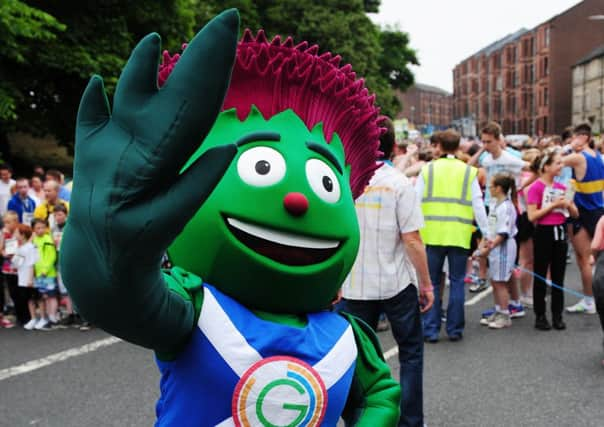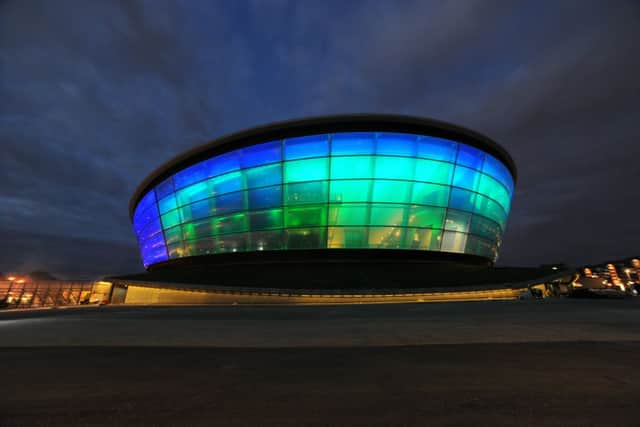Glasgow set to star in 2014 Commonwealth Games


Two badminton players enjoy a similar projection in Merchant City, towering over a square of rubble.
Patrons of Celtic Park can now behold, across the road, a shiny and silvery edifice that will be named for the first decade of its life as The Emirates Arena. It incorporates a state-of-the-art indoor velodrome that Sir Chris Hoy spent so long campaigning for that, when they built it, they named it after him.
Advertisement
Hide AdAdvertisement
Hide AdA short walk away on Springfield Road is the riverside Athletes’ Village, where the final bricks and mortar will be laid this month and which young professionals and families will call home when the Commonwealth Games are over.


Waterborne vessels can follow the Clyde down river from here until they catch sight of the futuristically beautiful SSE Hydro, which would have been built regardless of the Games but which will host some of the action. And on the south side of what some Glaswegians like to call their “Big Village”, Hampden Park is presently undergoing an internal facelift that will see its surface raised by six feet and an athletics track laid on top of steel stilts.
Glasgow looks different today to how it looked like before Glasgow 2014 was born as an entity six years ago, but not in a wholesale way. The improvements make the city look better and function better. None of the tweaks is ostentatious, which is indicative of a city that is not getting carried away. There are no white elephants raising the ire of taxi drivers.
The Commonwealth Games are a big deal, but just how big? The budget is £472.3 million, which is a lot more than the £18.3m it cost Edinburgh to put on the same event in 1986, but a lot less than the £8.92 billion it cost to stage the 2012 London Olympics. It is estimated that the 2014 Games will reach 1.5 billion people through TV and radio, which compares well with the Olympic reach of four billion. The potential for economic impact if Glasgow and Scotland take advantage of this opportunity for exposure is so great that it is not accurately quantifiable.
So far, it has been difficult to identify an aspect of Glasgow’s approach that has been flawed. Edinburgh’s preparations for the Commonwealth Games were seamless in 1970 but haphazard in 1986. In those days, there was no clear template, but now every government recognises that there is more to the Games legacy than a fortnight’s injection of tourism cash, and the Glasgow guardians have managed the project very conscientiously.
David Grevemberg, chief executive of the organising committee, believes the Barcelona and Sydney Olympics are most responsible for the behemoths that now take place and are about much more than sport.
He says: “In 1992, what Barcelona did was say that sport can regenerate and sport, importantly, can showcase culture, and that became incredibly compelling. That was matched with a fantastic commercial proposition, a fantastic social proposition and the idealism of bringing everyone together. Sydney 2000 was really the first Games that franchised a transfer of knowledge, and that became an industry in itself.
“I think Glasgow has done it in a way that is appropriate – perfect, in fact – to its context and its growth. The regeneration of the East End has established a really strong foundation of focus and awareness. The things that have been built are both world-class and community-relevant.”
Advertisement
Hide AdAdvertisement
Hide AdMr Grevemberg, a native of New Orleans, repeatedly peppers his description of his work with nouns such as “prudence” and “responsibility”, and adjectives such as “pragmatic” and “conservative”. He laughs when The Scotsman suggests these are words more commonly associated with Edinburgh, while popular lore has it that Glasgow is an open, carefree, loud and proud antidote. The opening ceremony, surely, will restore that reputation. Won’t it?
“The bottom line is that we are using public money so when I use words like prudence, it’s about being responsible in our approach,” says Mr Grevemberg. “Look at the pioneering work we are doing at Hampden as an example. We didn’t build a new stadium – we are raising the floor. It’s about being daring in the right places, because we want to bring this in on time and on budget. We also want it to be spectacular, and for people to be proud of it.”
The 2014 Commonwealth Games will take place over 11 days after the opening ceremony at Celtic Park on 23 July. An estimated 6,500 athletes will represent 70 countries in 17 sports, ranging in calories burned from swimming and boxing right down to lawn bowls and shooting.
More than a million tickets have been put up for sale online, and the first phase generated upwards of 2.3 million ticket requests. Of those, 57 per cent came from Scotland, with about 40 per cent from England, Wales and Northern Ireland, and the other 3 per cent from non-Commonwealth nations.
Mr Grevemberg acknowledges that the “double bounce” of staging a multi-sports event in close proximity to the outstanding London Olympics has had a bearing on the public clamour to be part of Glasgow 2014 (there were also more than 50,000 applications for the 15,000 “Clydesider” volunteer places). However, another factor was price.
If there is one characteristic shared between the people of Glasgow and Edinburgh, it is a reluctance to be ripped off. Very few sports enthusiasts would be duped into thinking that the Commonwealth Games carries the same cachet as the Olympics, so the fact that two-thirds of the tickets were priced at less than £25 created a message delivered at perfect pitch.
“There was a bit of discipline there and, without that, I don’t think we would have had the take-up, because people wouldn’t have trusted the message,” says Mr Grevemberg. “The fact that 92 per cent were sold out meant we surpassed our target, but also I was confident about hitting the £100m commercial revenue target and that was a nice big step to achieving that.”
That £100m in commercial revenue is dwarfed by the sum it is costing the taxpayer to put on this party. Glasgow City Council is contributing 15 per cent of the overall budget with the rest of the tab (67 per cent) picked up by the Scottish Government. It is cheaper than London 2012, which cost every adult in the UK £142, but the level of government input raises the question as to how much the political narrative of 2014 will interfere with the sporting one.
Advertisement
Hide AdAdvertisement
Hide AdMr Grevemberg is armed with a stock answer for this question. “Our standpoint for the Games is that we need to keep it an apolitical venture. We will create an environment where people can support their teams, and I haven’t had any indication that people are going to use this to push their own campaigns.”
He asserts that the Commonwealth Games Federation’s charter precludes the demonstration of political slogans at Games venues. But given that Team Scotland compete under the Saltire, there will be nothing to stop that flag being brandished with political intent. Unlike in 1986, however, when a mass anti-apartheid boycott had a detrimental impact on the quality of the sport, these Games should be strong enough to resist political sabotage. Everything points to Glasgow 2014 being remembered for the right reasons.
WHO TO WATCH
Here are five of the top home medal contenders for Glasgow 2014.
• Michael Jamieson: Hailing from the east end of Glasgow, the Bath-based 25-year-old was the top-performing British swimmer at London 2012 and won silver in the 200 metres breaststroke. Destined to be one of the “Faces of the Games”, the charismatic Jamieson has not yet won a major title but primarily because Daniel Gyurta of Hungary, who will not be in Glasgow, has a habit of pipping him to the wall.
• Eilidh Child: Having reached her first World Championship final last August in Moscow, finishing fifth, the Kinross runner has been on a steady upward curve and after winning a breakthrough silver at the Delhi Commonwealth Games in 2010, she will be expected to deliver Scotland’s first track-and-field gold since 1994. Her main competition is likely to come from Jamaica.
• Robert Blair and Imogen Bankier: Badminton, like swimming, has enjoyed a surge in recent years in Scotland and Bankier is the owner of a World Championships silver medal which she won in tandem with England’s Chris Adcock in 2011. Bankier will team up in Glasgow with the experienced Robert Blair, who has reversed his change of allegiance to England.
• Jen McIntosh: Delhi 2010 was a struggle for many Scots, but not for a shooter who, aged just 19, brought home two gold medals and one bronze. The action at Barry Buddon barracks might not be the most thrilling spectacle on show next summer but McIntosh says: “People tend to either find it very boring or very, very exciting.”
• Alex Marshall and Paul Foster: Bowls is played at elite level indoors and out, and Marshall and Foster are world pairs champions both on the lawn and the carpet. Between them they own a total of nine world titles and, if the weather plays ball, the greens of Kelvingrove Park could turn out to be one of the most fertile hunting grounds for Scottish medal-spotters at the Games.
THE VENUES
Advertisement
Hide AdAdvertisement
Hide Ad• Hampden Park (athletics): The turf of the national stadium was recently ripped up, with all key football matches this season diverted to Celtic Park and Ibrox.
• Ibrox Stadium (rugby sevens): While Celtic Park has the prestige of the opening ceremony, the Ibrox turnstiles host two days of quickfire rugby action.
• Emirates Arena (badminton): One of the largest arenas of its kind in Europe, the new venue boasts action on six courts.
• Sir Chris Hoy Velodrome (cycling): Another brand new venue, and one that was sadly lacking in Scotland during Sir Chris Hoy’s tenure.
• National Hockey Centre (hockey): Ten men’s and women’s teams will grace the new carpet-like astroturf at Glasgow Green, with Australia the ones to beat.
• Tollcross Park (swimming): Now a swimming facility of the very highest standard, this is where the best chance of Scottish medal success lies.
Kelvingrove Park (lawn bowls): Five reconstructed bowling greens set against Glasgow’s finest vista.
• SECC Precinct (multiple): Between the Armadillo, the SECC itself and the new Hydro, this Clydeside venue will draw fans of boxing, gymnastics, judo, netball, weightlifting and wrestling.
Advertisement
Hide AdAdvertisement
Hide Ad• Scotstoun Sports Campus (squash, table tennis): Adjacent to the new home of Glasgow Warriors is the home of Scottish badminton, but there are also six squash courts here and one of the glass-walled variety will be constructed for the finals.
• Strathclyde Country Park (triathlon): The original home of T in the Park will stage exuberance of another kind as the amazing Brownlee brothers prove why they are the best in the world.
• Cathkin Braes (mountain biking): Just 15 minutes from the Athletes Village, this is state-of-the-art terrain.
• Royal Commonwealth Pool (diving): The Commonwealth Games return to the shadow of Arthur’s Seat in Edinburgh for a third time.
• Barry Buddon Centre (shooting): The Carnoustie barracks opens its doors to international sport as Scotland’s finest marksmen and women go for gold.